Intel X58 Motherboard Roundup - What does $300 Get You?
by Gary Key on December 5, 2008 3:00 PM EST- Posted in
- Motherboards
Gigabyte GA-EX58-UD5
Features
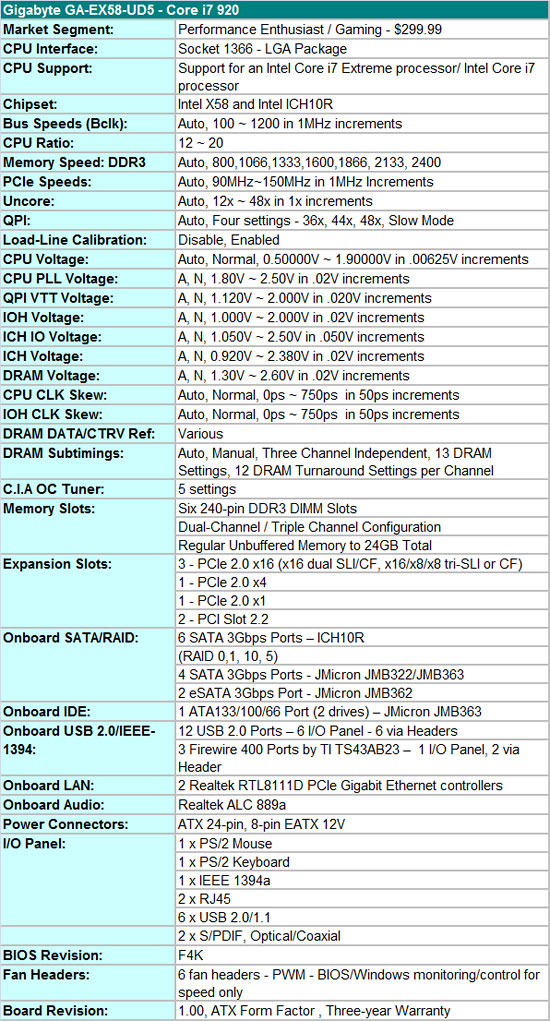
We have to hand it to Gigabyte; if there was an empty spot on the board during the design phase, they figured out a way to add a feature in that space. This board is loaded with everything but the kitchen sink and yet it appears mostly uncluttered; only when using the board do you sometimes notice that it is crowded. Gigabyte throws in twin Realtek RTL-8111D PCIe Gigabit Ethernet controllers that can be teamed; the Realtek ALC-889a is on board for HD audio and features real-time Dolby Digital Live encoding; JMicron’s JMB322/363 chipsets are tabbed for IDE and additional SATA port duties; TI is selected for IEEE 1394a; and the Intel ICH10R is onboard for primary storage purposes.
The BIOS is designed for those who like to tweak for a living. For some, the number of available options will be overwhelming while others will take joy in squeezing out every last little bit the board has to offer. The number of memory timing options is immense and includes the ability to setting timings for each individual channel. However, as we also found with the ASUS board, the auto settings are not always spot on.
Also, the latest beta BIOS we utilized (F4H) has a habit of overriding manual memory settings. This can be a good and bad decision on behalf of the BIOS. The good is that it will do its best to keep the user out of trouble; the bad is that when we manually tweak a board we would like to know when we are in trouble. In the end, the settings determined by the BIOS were always stable and performance was generally not detrimental. We will look at this as a glass half full situation. (update - BIOS F4K received today corrects this problem)
The only nitpick we truly have with the BIOS centers on Load-Line calibration. The purpose of this setting is to reduce VDroop and it works perfectly on the other boards. On our particular board sample we still noticed VDroop when a VCore setting of 1.425V resulted in 1.392V real. Gigabyte is aware of this and is working on it now. Otherwise, we commend Gigabyte for a well laid out BIOS and for offering the enthusiast just about every option one could use on a board.
Gigabyte supports a stock 800MHz ~ 2400MHz memory speed on the i920/i940 processors along with opening up QPI link speeds from a standard 4.800 GT/s up to 6.400 GT/s. They also include a slow mode QPI link speed for high Bclk testing. The board supports up to 24GB of DDR3 memory. We have not had any problems running 12GB of our Patriot or G.Skill DDR3-1600 kits with the latest F4H BIOS. Our final settings are at 1600 with 9-9-9-24 1T timings at 1.66V. Although the timings are looser than the other boards, performance is basically equal; only a user looking for that last bit of advantage in a benchmark would notice a difference.
The three PCI Express 2.0 x16 slots will operate in x16/x16 mode for 2x SLI/CF if the third x16 slot is empty. If you decide to place a PCIe RAID, network, audio, or TV tuner card in the third x16 slot, then the 2x SLI/CF configuration will operate in x16/x8 mode. 3x SLI/CF configurations will run in x16/x8/x8 mode. We had no problems running our ASUS Xonar D2X or Highpoint Rocket RAID cards in x16 slots two or three.
The Board
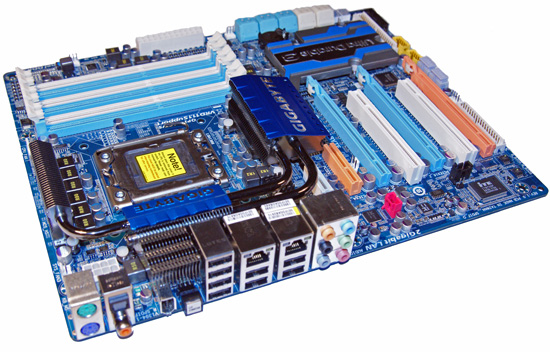
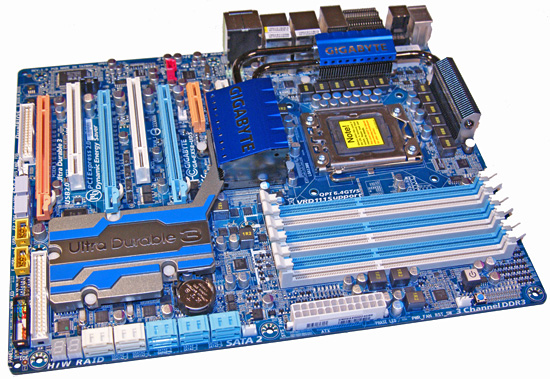
The $299 GA-EX58-UD5 is Gigabyte's mid-range X58 board, with the Extreme version being at the top end with a $330 price tag and the DS4 board placed at the low end with a $245 street price. We think Gigabyte's product separation is right on considering the feature set on each board, although we had hoped the DS4 would also have SLI capability considering the additional cost when compared to the MSI Platinum board.
Gigabyte introduced a new color palette on this board and we like it for the most part. We still notice a few of the crayola colors in use but overall this board would not look bad in a case with a large window. The one item that stands out on the board is the rather large heatsink for the ICH10R/JMicron controllers proudly displaying the Ultra Durable 3 technology incorporated on the board. Ultra Durable 3 refers to Gigabyte's use of solid-state Japanese capacitors, ferrite core chokes, and low RDS(on) MOSFETs along with an extra dose of copper in the board layers.
All of this is meant to improve overclocking potential and extend the life of the board. Until we get to our sub-zero overclocking article, it has been difficult to notice any overclocking differences between this board and the others in our roundup. However, we do appreciate the high quality components that Gigabyte included at this price point.
Gigabyte provides a hefty combination of heatsinks for the northbridge and vrm areas that link together with a heatpipe system. In fact, part of the first VRM heatsink extends into the IO panel to provide an exhaust outlet for the cooling system. Of course this system relies on radial type cooling for proper heat dispersion. We highly recommend direct air-cooling in this area if you are utilizing a tower heatsink/fan for the CPU or water-cooling when overclocking.
The CPU area is fairly open and our larger air coolers installed perfectly without interference from the heatsinks. However, a large air cooler like the Monsoon Vigor III that we utilized will render the first DIMM socket unusable, essentially limiting you to only populating three of the DIMM slots. This board features a two-phase power delivery system for the northbridge and a two-phase delivery for the memory subsystem. A twelve-phase power delivery design is utilized for the processor, which could be construed as overkill, but it does serve its purpose when overclocking. Like the other boards, the capacitors in the CPU area are fairly close to the 1366 socket, something that is important to note when utilizing other cooling methods like large water blocks, cascade, or LN2 setups.
The general layout is very good considering the vast number of ports, slots, and hardware included on the board. Gigabyte's design keeps interference to a minimum with installed peripherals for the most part. The board includes three PCI Express 2.0 x16 slots (x16/x8/x8), one PCIe x1 slot, a single x4 slot, and two PCI slots. This arrangement allows 3X Crossfire or SLI and still leaves the PCIe x1 and x4 slots open. However, using double slot cards for CF or SLI will render the PCI slots physically unusable. It is at this point that we realized a couple of potential problems with this layout.
The first PCIe x1 slot can only be utilized with a half length card, which excludes most audio and tuner cards. The bigger problem is that when utilizing two double slot cards for CF or SLI, the cards sit right next to each other, which inhibits airflow. The same holds true when utilizing the third x16 slot. When installing a dual-slot card in the third slot, it will hangover the board, which could create an installation problem in most cases. We do not care for 3X CF/SLI for general gaming, so we would have preferred a proper dual x16 design or an additional slot between the first two x16 slots to improve cooling or allow water-cooling on the GPUs.
At the rear of the board are the ten SATA ports, a Debug LED display unit, and the IDE connector. The gigantic heatsink covers the ICH10R and the JMB 363/322 controller chipsets. The JMB322s are responsible for the two white SATA ports and offer driver-free RAID 0 and 1 support. The hardware stack in the JMB322 makes arrays appear as standard hard drives and hence the lack of required software drivers when setting them up. Gigabyte took a different approach and hooked the JMB322s directly into JMB363 SATA ports instead of riding on the PCI Express bus as they do on the MSI board. This results in slightly lower performance as our PCMark Vantage HDD test suite will indicate later on. All ten SATA ports have a right angle cable connection scheme that allows them to be utilized even with the longer double-slot video cards. About the only drawback is placing this board in a smaller case where the drive bays would butt up against the board. Even so, we feel this arrangement is the right way to go.
In a change from other board designs, Gigabyte locates the power on and reset buttons behind the DIMM slots, an unusual location but one that we grew accustomed to quickly. At the front of the board Gigabyte places their dual BIOS chips, which can come in handy in case a flash attempt goes south. Also, they figured out a way to include a floppy connector, although we no longer care to see them on boards in this market sector. Gigabyte also throws in some onboard LEDs to light up your life. Actually, they do serve a purpose besides looking cool in a windowed case at night: the LEDs will let you know how many phases are being utilized by the board during operation.
The IO panel features eight USB 2.0 ports, two Ethernet jacks with LED indicators, an IEEE 1394a port, standard PS/2 keyboard/mouse ports, coaxial and optical S/PDIF output ports, and a handy clear CMOS button. The audio panel offers connections to the Realtek ALC 889a HD audio codec. The one thing missing on this board is a fixed eSATA port. However, Gigabyte includes an expansion slot backplate that allows an additional two external SATA ports via any of the board's internal SATA connections.
The Applications
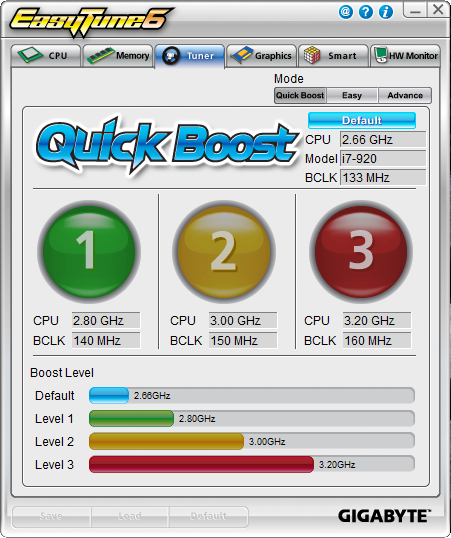
Gigabyte provides their EasyTune 6 application that provides monitoring, system information, and overclocking capabilities. This is one of the best applications provided by the various motherboard suppliers for tuning the system within Windows. We would still like to see the ability to save the settings to the BIOS or at least a BIOS profile; otherwise, this application is useful for extracting a fair amount of performance improvement out of the system within Windows.
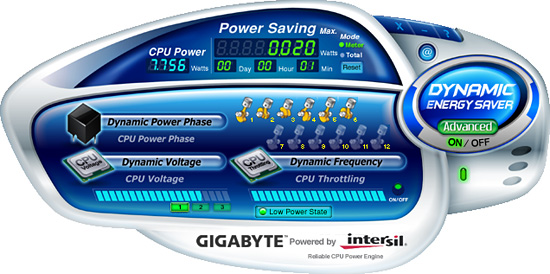
Gigabyte recently updated their DES (Dynamic Energy Saver) software so it is compatible with the X58 chipset, along with providing BIOS improvements. Our original F2 BIOS would not work properly with the latest DES beta but the F4 series has made great strides in this department. We noticed a 5W improvement in idle rates and a 1W improvement in our load tests with DES. Gigabyte expects some additional savings once the software and BIOS are finalized. The DES system offered fast switching times once a full load was placed on the system and we did not experience any crashes during our benchmark tests.






















78 Comments
View All Comments
mvrx - Wednesday, December 10, 2008 - link
I know these motherboards are months away, but please include dual socket i7 reviews as soon as they become available for testing. My next system will be a dual i7 quad for sure and I'm anxiously awaiting these MB's to come out and mature.I didn't go with current dual socket architectures because of FB-DIMMs limiting the performance and costing so much more. Really hoping to see a resurgance of the dual+ socket enthusiast systems.
And if anyone replies "What can you be using that even takes up a single socket quad core" - well.. then you probably don't know enough about enthusiast computing to reply here. ;-)
strikeback03 - Wednesday, December 10, 2008 - link
I'd think that last line shows why we are unlikely to see a resurgence of multi-socket enthusiast systems. There are very few that have applications which would take advantage of more than 4 physical cores/8 logical cores.mvrx - Thursday, December 11, 2008 - link
Well, I approach it with this logic..... and I get this alot from people.. "few applications that take advantage of more than 4 cores". I'm not running one or two applications....
MS OneCare (or your chosen security suite), seems to zap 15%-20% of overall system performance depending on what it's doing.
Even my old LOTR BFME2 ROTWK game spans 4 cores.. Not very well, but it does.
I run a skype conference server for gamers (an upcoming competitor to Ventrilo) with 20 or so callers on the line at once. Skype (especially skype 4.0) spans many cores reasonably well. (s4pg.us - website's not up yet)
I like to leave my email, web browsers, etc - open when I play my games.. and unfortunately I probably have another 10 active programs sitting in the background in some way. According to resource manager I have about 1100 active threads running, I think the average enthusiast only would have 500-700.
Now, I may be the upper-end of the catagory of heavy resource users, but thats mostly because people don't have the horsepower to do more so they don't. Chicken and Egg issue. If I can get a i7 for $300, and maybe the dual socket MB costs me a $150 premium, I'm sure as heck going to go dual socket.
I know one of my biggest issues is HD performance, but I hope to fix that with one of Micron Tech's new PCIe SSD cards... At that point, I'll probably be easily slamming two i7's. And I do like to run x264 mp4 compression jobs overnight. Even if it only liked using 4 cores, I can run several instances at once.
According to the roadmaps, the X58 is dual socket ready.. So I doubt it will be long until we see at least a few boards.
anindrew - Wednesday, December 10, 2008 - link
I had already ordered and received most of my parts for my new X58/i7 920 based system before this article went up. I was anxiously waiting for it to see what Anand and crew thought. Like so many commented here, I had no idea Anandtech's crew helped sort out issues with motherboards and BIOSes. I think it would be interesting to hear more about that and specifically why you did that (by choice or to help everyone).I built my system yesterday using the Gigabyte GA-EX58-UD5, i7 920, and 6GB of G.Skill DDR3-1600 8-8-8-21 memory (those are the actual specs of it). I have had no problems at all setting the system up. Everything works as it should. I have not tried to overclock yet, but I will since I have the Noctua SE1366.
The Asus P6T does look great, and I am happy to hear that it worked as it should right away. I had to debate between the Asus and Gigabyte boards. In the end, I chose the Gigabyte because I got a $30 discount in a combo with the Geforce GTX260 core 216. Time will tell if I made the right choice. :-)
chuckbam - Tuesday, December 9, 2008 - link
I member of ABXZone.com pointed out to me that the ASUS P6T Deluxe has a memory range conflict on the device I/O APIC controller. Does anyone have more information on this?http://chuckbam.com/Posts/IOAPIC.PNG">http://chuckbam.com/Posts/IOAPIC.PNG
chrhon - Tuesday, December 9, 2008 - link
Thank you for bringing up those comments at the begging of the article. Pretty much everyone I talk to is fed up with motherboard problems and even considering something such as buying from Dell. These mobo manufacturers are shooting themselves in the foot. Sadly the reviews seem to help them.My last build I started with a Gigabyte board and it was good to me but there were complaints on all the reviews on the memory overclocking. Then that board stopped working for me and I bought a DFI board that was universally praised by the reviews and it was the biggest pain in the ass - almost every time I would add or remove a card or flash the BIOS I would go through non-POST hell. I don't see myself EVER buying a DFI board again based on that experience.
If a motherboard company comes out bragging about its quality components and stability THAT is where I am going to put my money. Believe it or not its things like chipset fans being cheap and going out that make more difference in long term satisfaction of a board than one more (when there are already 50) way to tweak some voltages.
Kroneborge - Tuesday, December 9, 2008 - link
Reliability is definitely key. Fast doesn’t matter if your computer won’t run. I do music production, along with my games, and I want a system that is going to run all the time with no problems. If that means I can’t overclock, then I would rather do that. I definitely suggest adding a reliability chart so those of us who need computers for production purposes can factor that in.Also for music production having 12gb or even 24 is perfectly reasonable for large sample libraries. Manufacturers that think supporting those sizes (as advertised) isn’t a priority are wrong.
Thanks for the great review, and please continue to put an emphasis on things working. And keep updating stuff so we know where they stand. I for one won’t be purchasing my new computer till I’m sure I can get it working with little fuss right out of the box.
SiliconDoc - Tuesday, December 9, 2008 - link
That was very kind of you Anand - to point out how the monster that was created is out of control...rofl - I couldn't help thinking - imagining - it's just like the bankers/loan officers/fannie n freddie freaks that fried the economy with wild eyed speculation and housing bubbling... just crazed wackos doing "what must be done" in the name of ... well profits or chest thumping or bonuses or bragging rights or all the above in all cases...
Now the crash and burn of simple motherboard features not even working is splaying out in the public - I've seen the posted reports by the end users...
"We don't have to do it right - or even ethically *advertised features actually work* - seems to be the call of the day everywhere.
So anyway - good job actually EXPERIENCING THE LAST STRAW AND TRYING TO DO SOMETHING ABOUT IT .
Hopefully the pendulum will swing back toward center without anyone getting fragged... (although I'm sure purchasers in some cases wish otherwise).
SiliconDoc - Tuesday, December 9, 2008 - link
PS - Yes, so that I'm not missing something either - it DOES sound like they owe Anand and the staff about a million bucks (each).I can see how a good review here and there has now ballooned into "lab support" ....
A million bucks each ought to do - the manufacturers can take up an R&D collective - if they threaten to cut off boards just do a maniacal laugh - they will crumble and pay up.
;-)
araczynski - Monday, December 8, 2008 - link
mildly interesting, but personally i'd like to see this in comparison to something from the 'normal' lineup, you know, like what most people currently have.throw a C2D/3ghz/4gb in there and then we have something interesting.
compare apples to apples, not just apples to themselves.